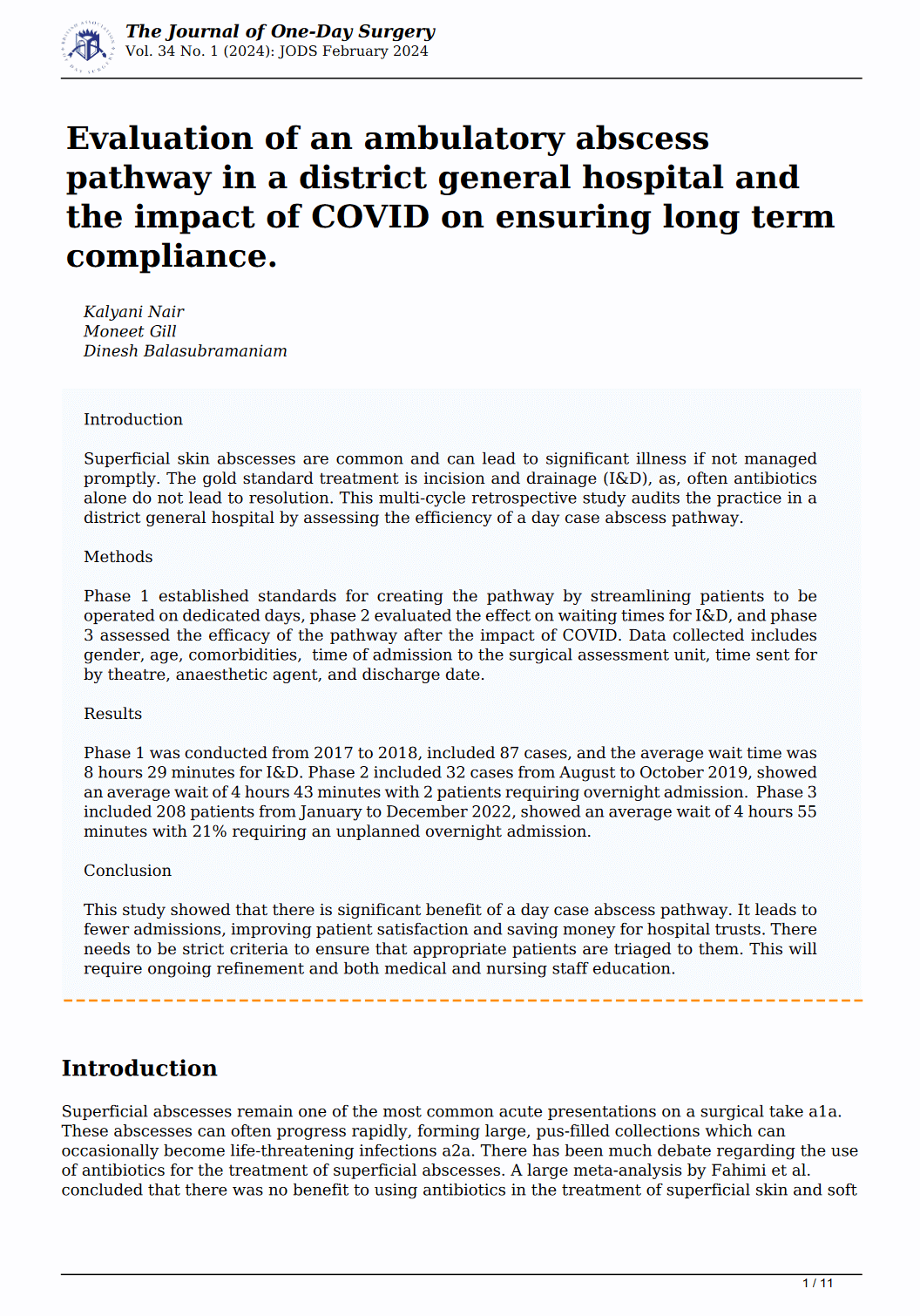Evaluation of an ambulatory abscess pathway in a district general hospital and the impact of COVID on ensuring long term compliance.
Main Article Content
Abstract
Introduction
Superficial skin abscesses are common and can lead to significant illness if not managed promptly. The gold standard treatment is incision and drainage (I&D), as, often antibiotics alone do not lead to resolution. This multi-cycle retrospective study audits the practice in a district general hospital by assessing the efficiency of a day case abscess pathway.
Methods
Phase 1 established standards for creating the pathway by streamlining patients to be operated on dedicated days, phase 2 evaluated the effect on waiting times for I&D, and phase 3 assessed the efficacy of the pathway after the impact of COVID. Data collected includes gender, age, comorbidities, time of admission to the surgical assessment unit, time sent for by theatre, anaesthetic agent, and discharge date.
Results
Phase 1 was conducted from 2017 to 2018, included 87 cases, and the average wait time was 8 hours 29 minutes for I&D. Phase 2 included 32 cases from August to October 2019, showed an average wait of 4 hours 43 minutes with 2 patients requiring overnight admission. Phase 3 included 208 patients from January to December 2022, showed an average wait of 4 hours 55 minutes with 21% requiring an unplanned overnight admission.
Conclusion
This study showed that there is significant benefit of a day case abscess pathway. It leads to fewer admissions, improving patient satisfaction and saving money for hospital trusts. There needs to be strict criteria to ensure that appropriate patients are triaged to them. This will require ongoing refinement and both medical and nursing staff education.
Downloads
Article Details
References
Spellberg B. Skin and soft-tissue infections: modern evolution of an ancient problem. Clin Infect Dis. 2010;51(8):904-6.
Stevens DL, Bisno AL, Chambers HF, Dellinger EP, Goldstein EJ, Gorbach SL, et al. Practice guidelines for the diagnosis and management of skin and soft tissue infections: 2014 update by the Infectious Diseases Society of America. Clin Infect Dis. 2014;59(2):e10-52.
Fahimi J, Singh A, Frazee BW. The role of adjunctive antibiotics in the treatment of skin and soft tissue abscesses: a systematic review and meta-analysis. Cjem. 2015;17(4):420-32.
Fitch MT, Manthey DE, McGinnis HD, Nicks BA, Pariyadath M. Videos in clinical medicine. Abscess incision and drainage. N Engl J Med. 2007;357(19):e20.
Buck N, Devlin, H B , Lunn, J N The report of a confidential enquiry into perioperative death. Proceedings from a confidential enquiry into perioperative death. 1987. Available from: https://www.nuffieldtrust.org.uk/research/the-report-of-a-confidential-enquiry-into-perioperative-death
NHS England. National Day Surgery Delivery Pack [internet], Getting it right first time; 2020 [updated August 2021, cited October 2023]. Available from: http://www.gettingitrightfirsttime.co.uk/wp-content/uploads/2021/08/National-Day-Surgery-Delivery-Pack_Aug2021_final.pdf
Gaszynski R, Gray A, Chan DL, Merrett N. Fast-track ambulatory abscess pathway: an Australian streamlined emergency surgery pathway. ANZ J Surg. 2020;90(3):268-71.
Li C, Nguyen P, Garg P, Pham H, Hitos K, Pang T. Improving Quality Metrics with a Day-only Skin Abscess Protocol: Experience from Australia. World J Surg. 2023;47(6):1486-92.
Ali AB, Shaikh A, Maghami N, Zia M, Wolf DA, Bonville DJ. Impact of Covid-19 pandemic on volume and surgeon professional fees generated by emergency general surgery procedures. Surg Endosc. 2022;36(12):9297-303.
Maguire D. The hidden problems behind delayed discharges and their costs. 2023. [updated 30 March 2023, cited October 2023] Available from: https://www.kingsfund.org.uk/blog/2023/03/hidden-problems-behind-delayed-discharges
Fahrner R, Bähler S, Lindner G. COVID-19 lock-down significantly reduced number of surgical presentations in an emergency department. Wiener klinische Wochenschrift. 2021;133(7):399-402.
Baker C. NHS Key Statistics: England, July 2023. 2023. Available from: https://commonslibrary.parliament.uk/research-briefings/cbp-7281/


